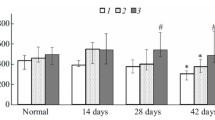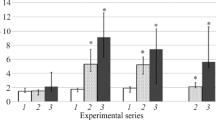Summary
O2-upptake, formation of lactat in aerobic and anaerobic conditions and conversion of glucose-C-6 to CO2 was measured in 32 endometrial biopsies after oral administration of combination preparationes and compared with the same parameters in 42 biopsies from normal menstrual cycles. The results showed a reduction of the endometrial oxygen consumtion to almost half the value after oral contraceptives. The endogenous aerobic and anaerobic lactic formation increased hightly significantly in the controlgroup from the proliferative to the secretory phase. When influenced by the combination preparationes the lactic formation was only slightly increased in the first part of the cycle but was very low during the second phase.
In the normal endometrium the conversion of glucose-C-6 to CO2 is gradually lowered when passing from proliferative to secretory phase. In the hormonally treated endometrium the conversion values are low in the beginning of the cycle and moderatly increased in the later part. The courves of both the lactic formation and glucose-C-6-conversion during the menstrual cycle in the treated group are thus inverted compared with the courves from the control group.
The ratio of endometrial aerobic/anaerobic metabolism is the same during the first phase of the hormonal treatment as in the secretory phase of the normal cycle. These results indicate that the changed endometrial metabolism may play a part in the anticonceptional effect of these drugs.
Similar content being viewed by others
Literatur
Adler, K.: Der Gewebsstoffwechsel der Uterusschleimhaut in den verschiedenen Stadien ihrer biologischen Funktion. Arch. Gynäk.141, 306 (1930).
Arronet, G. H., andJ. P. A. Latour: Studies on endometrial Glycogen. J. clin. Endocr.17, 261 (1957).
Drill, V. A.: Oral contraceptives, p. 80–85. New York: McGraw-Hill Book Co. 1966.
Flowers, C. E.: Effects on new low-dosage form of norethynodrelmestranol; clinical evaluation and endometrial biopsy study. J. Amer. med. Ass.188, 1115 (1964).
Hackl, H.: In vitro Stoffwechselstudien des Carcinoma corporis uteri. Arch. Gynäk.203, 464 (1966).
—: In vitro Stoffwechselstudien normaler humaner Ovarien, benigner und maligner Ovarialtumoren. Arch. Gynäk.204, 4, 167 (1967).
Hagerman, D. D., andC. A. Villee: Effects of the menstrual cycle on the metabolism of the human endometrium. Endocrinology53, 667 (1953).
Hammerstein, J., u.F. Zielske: Die Korrelation zwischen dem Glykogengehalt im Endometrium und der Pregnandiolausscheidung im Harn bei der geschlechtsreifen Frau. Z. Geburtsh. Gynäk.158, 47 (1962).
Hess, B.: Über eine kinetisch-enzymatische Bestimmung der L(+)-Milchsäure im menschlichen Serum und anderen biologischen Flüssigkeiten. Biochem. Z.328, 110 (1956).
Hughes, E. C., R. J. Jacobs, A. Rubulis, andR. Husney: Carbohydrate pathways of the endometrium. Amer. Obstet. Gynec.85, 594 (1963).
—,A. W. vanNess, andC. W. Lloyd: The nutritional value of the endometrium for implantation and in habitual abortion. Amer. J. Obstet. Gynec.59, 1292 (1950).
Jackson, M.: Comparison of norethynodrel and norethisterone in patients. J. Endocr.25, XXVI (1962).
Karlson, P.: Biochemie. Stuttgart: G. Thieme 1964, S. 274.
McKay, D. G., A. T. Hertig, W. A. Bardawil, andJ. T. Velardo: Histochemical observations on the Endometrium. Obstet. and Gynec.8, 22 (1956).
Raab, E.: Der Stoffwechsel der überlebenden Uterusschleimhaut. Arch. Gynäk.138, 726 (1929).
Rice-Wray, E., J. W. Goldzieher, andA. Aranda-Rosell: Oral progestins in fertility control. A comparativ study. Fertil. and Steril.14, 402 (1963).
Roland, M.: Progestagen therapy, p. 24. Springfield: Ch. C. Thomas 1965.
Ryan, G. M., J. Craig, andD. E. Reid: Histology of the uterus and ovaries after longterm cyclic norethynodrel therapy. Amer. J. Obstet. Gynec.90, 715 (1964).
Saksena, K. C., M. M. Arora, J. C. Gupta, andC. M. Rangam: Histochemical studies in histologically normal endometrium. J. med. Sci. India19, 121 (1965).
Siegel, P., u.G. Heinen: Die Reaktion des Endometrium auf die zyklische Behandlung mit Ovulationshemmern. Geburtsh. u. Frauenheilk.25, 312 (1965).
Stürmer, V. M., andR. J. Stein: Cytodynamic properties of the enzymatic activity of the human endometrium during the menstrual cycle. Amer. J. Obstet. Gynec.63, 359 (1952).
Zondek, B., andL. Stein: Glykogen content of the human uterine mucosa. Glycopenia uteri. Endocrinology27, 395 (1940).
Author information
Authors and Affiliations
Additional information
Frl. Britt-Marie Haglund sei für die gewissenhafte Durchführung der Stoffwechseluntersuchungen herzlich gedankt.
Rights and permissions
About this article
Cite this article
Hackl, H. Der Effekt Peroraler Antikonzeptionsmittel auf den in vitro-Glucosestoffwechsel des Endometrium. Arch. Gynak. 205, 398–409 (1968). https://doi.org/10.1007/BF00668737
Received:
Issue Date:
DOI: https://doi.org/10.1007/BF00668737




